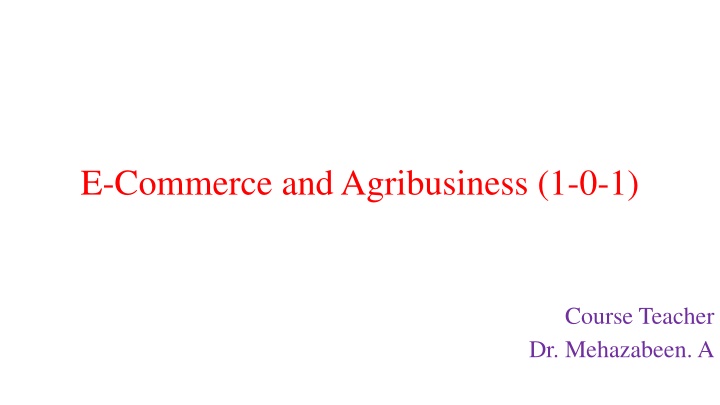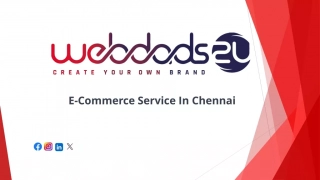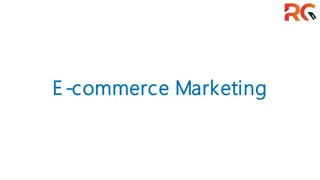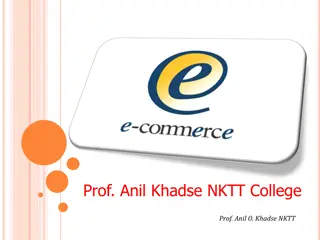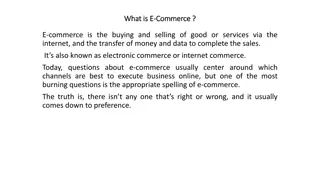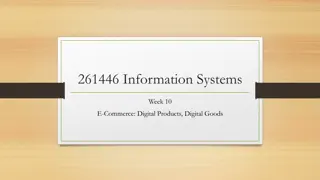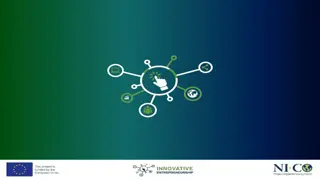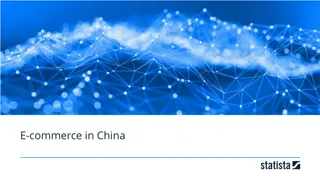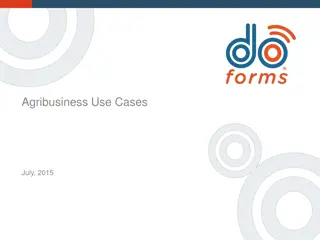Introduction to E-commerce and Agribusiness
E-commerce refers to using the Internet for business transactions, while agribusiness focuses on agricultural activities. This course explores the intersection of these fields, their historical evolution, key features of E-commerce, and the impact on agricultural practices.
Download Presentation

Please find below an Image/Link to download the presentation.
The content on the website is provided AS IS for your information and personal use only. It may not be sold, licensed, or shared on other websites without obtaining consent from the author.If you encounter any issues during the download, it is possible that the publisher has removed the file from their server.
You are allowed to download the files provided on this website for personal or commercial use, subject to the condition that they are used lawfully. All files are the property of their respective owners.
The content on the website is provided AS IS for your information and personal use only. It may not be sold, licensed, or shared on other websites without obtaining consent from the author.
E N D
Presentation Transcript
E-Commerce and Agribusiness (1-0-1) Course Teacher Dr. Mehazabeen. A
E-Commerce Introduction E-commerce means using the Internet and the web for business transactions and/or commercial transactions, which typically involve the exchange of value (e.g., money) across organizational or individual boundaries in return for products and services. Originally, electronic commerce meant the facilitation of commercial transactions electronically, using technology such as Electronic Data Interchange (EDI) and Electronic Funds Transfer (EFT). These were both introduced in the late 1970s, allowing businesses to send commercial documents like purchase orders or invoices electronically. The growth and acceptance of credit cards, automated teller machines (ATM) and telephone banking in the 1980s were also forms of electronic commerce. Another form of E-commerce was the airline and railway reservation system. Online shopping, an important component of electronic commerce was invented by Michael Aldrich in the UK in 1979.
The worlds first recorded business to business was Thomson Holidays in 1981. The first recorded Business to consumer was Gateshead SIS/Tesco in 1984. During the 1980s, online shopping was also used extensively in the UK by auto manufacturers such as Ford, General Motors and Nissan. In 1990 Tim Berners-Lee invented the World Wide Web and transformed an academic telecommunication network into a worldwide everyman everyday communication system called internet/www(dot). By the end of 2000, many European and American business companies offered their services through the World Wide Web. Since then people began to associate a word E-commerce with the ability of purchasing various goods through the Internet using secure protocols and electronic payment services.
The term electronic commerce refers to any sort of business transaction that involves the transfer of information through the internet. It covers a variety of business activities which use internet as a platform for either information exchange or monetary transaction or both at times. The numbers of consumer brand retail sites like Amazon.com, Flipkart.com, which normally provides information about products and also allows monetary transactions to happen over the internet. On the contrary there are the auctions sites like Quickr.com and Ebay.com where the information about certain listed products and services are provided but the monetary transactions normally happen physically. Apart from these two categories of e-commerce sites, there are some sites which enable businesses to exchange trading goods and also service between two or more companies. All of these forms of internet based business platforms are known as e-commerce.
E-Commerce has pertain key features which are explained as follows 1. E-Commerce is Technology-Enabled Traditional commerce is taking place since times immemorial but E-commerce is result of integration of digital technology with business processes and commercial transactions. The technological foundations of E-commerce are internet, WWW and various protocols. 2. Technology Mediated In E-commerce buyers and sellers meet in cyber space rather than physical place. Hence E-commerce does not involve face to face contact. 3. Universality Buying and selling take place through websites in E-Commerce. The websites can be accessed from anywhere around the globe at any time therefore it possess the feature of universality.
4. Intercommunication E-commerce technology ensures two way communications between buyer and seller. On one hand by using E- commerce firms can communicate with customers through E-commerce enabled websites. On the other end, customers can also fill order forms, feedback forms and can communicate with business operating firms. 5. Delivery of Information E-commerce serves as the best channel of communication. E-commerce technologies ensure speedy delivery of information at very low cost and considerably increase information density as well. 6. Electronic Completion of Business Processes By using E- commerce we can perform business transactions like accounting and inventory through computers at global level.
7. Virtual Communities Virtual Communities are online communities created by means such as chat rooms and specifically designed sites like, where people can interact with each other having common interest using the internet. 8. Inter-Disciplinary in Nature Implementation of E-Commerce needs a lot of knowledge of managerial, technological, social and legal issues. Besides this, understanding of consumer behaviour, marketing tools and financial aspects is as crucial as designing interactive E- Commerce websites. 9. Customization With the use of E-commerce technology, the world is moving from mass-production to mass-customization. Product customization ensures that goods are tailor made as per the requirements and preferences of customers.
Key Drivers in Indian e-Commerce The main drivers of e-commerce in India are as follows: A large percentage of population subscribed to broadband Internet, burgeoning 3G internet users, and a recent introduction of 4G across the country. The explosive growth of Smartphone users, soon to be world's second largest Smartphone user base. Rising standards of living as result of a fast decline in the poverty rate. Availability of much wider product range (including long tail and Direct Imports) compared to what is available at brick and mortar retailers. Competitive prices compared to brick and mortar retail driven by disintermediation and reduced inventory and real estate costs. Increased usage of online classified sites, with more consumers buying and selling second-hand goods
E-commerce - Business models Business model defines how a company runs its operations & generates revenue. Every viable organization is built on a sound business model. Selecting an ecommerce business model is a challenge, especially for beginners who have little to no experience in the industry. If a business model is successfully executed, an ecommerce venture can become a significant source of income.
1. B2B Business model A website following the B2B business model sells its products to an intermediate buyer who then sells the product to the final customer. As an example, a wholesaler places an order from a company's website and after receiving the consignment, sells the end product to the final customer who comes to buy the product at one of its retail outlets.
2. B2C Business model A website following B2C business model sells its products directly to a customer, the end user. A customer can choose the products shown on the website and place an order for them. They may use banking channels or payment on delivery options. There are two broad categories under this model 1. Direct selling 2. Market place model.
I. Direct selling refers to the manufacturer or wholesaler of the product/brand selling their goods directly to the customers on their own website.
Examples Flipkart Flipkart started off with a direct-to-consumer model selling books and some other products, before turning to a marketplace model which connect sellers and buyers and expanding its catalogue. The sources of income to Flipkart include seller commission, advertisements, logistics and convenience fees. Just dial Justdial is India s search engine for local search market which initially started as a classified website but soon transformed into a local search engine. They used word-of-mouth strategy to advertise themselves. Focussing on local brands and small businesses, the company became famous among the masses. Urban Clap Urban Clap is a company that provides a variety of services of professionals and blue collar workers at the convenience of customers home. Once can hire electricians, yoga trainers, lawyers, engineers, chartered accountants, beauticians, photographers, interior designers, etc.
3. C2C business model A website following the C2C business model helps consumers to sell their assets by publishing their information on the website. Website may or may not charge the consumer for its services. Another consumer may opt to buy the product of the first customer by viewing the post/advertisement on the website.
4. C2B business model In this model, a consumer approaches a website showing multiple business organizations for a particular service. The consumer places an estimate of amount he/she wants to spend for a particular service.
Examples Freelancer.com Freelancer is an Australian crowd sourcing marketplace website, which allows potential employers to post jobs that freelancers can then bid to complete. Where the freelancers are mostly individuals who provides personalized jobs to the business organizations for some consideration. This is one of the best examples for C2B e-commerce business model. Upwork.com Another best example for this model is Upwork.com. Through Upwork, businesses get more done, connecting with proven professionals to work on projects from web and mobile app development to SEO, social media marketing, content writing, graphic design, admin help and thousands of other projects. Upwork makes it fast, simple, and cost-effective to find, hire, work with, and pay the best professionals anywhere, any time.
G2C Business model Governments use G2C model websites to approach citizen in general. Such websites support auctions of vehicles, machinery, or any other material. Such website also provides services like registration for birth, marriage or death certificates. The main objective of G2C websites is to reduce the average time for fulfilling citizen s requests for various government services.
G2G models Government to government (G2G) is the electronic sharing of data and/or information systems between government agencies, departments or organizations. The goal of G2G is to support e-government initiatives by improving communication, data access and data sharing. When the exchange of information and services is within the periphery of the government, is termed as G2G interaction. This can be both horizontal, i.e. among various government entities and vertical, i.e. between national, state and local government entities and within different levels of the entity.
C2G Model This model indicates the transactions between government and consumers. Where consumer provides any services or feedback that adds value to the government administration or authorities. It is an electronic platform where consumers interact with the government. It covers the areas such as election, votes, and taxation. The C2G, short for Consumer to Government e-commerce business allows consumers to provide feedback or ask for information about government authority from the public sector. When you pay an electricity bill via the government website, it is a favorite e-commerce business model. Hence, the C2G model of business allows consumers to reach higher authorities without going around in circles. Example: A consumer can pay his income tax or GST online. The transaction involved in this case are C2G transactions.
e-commerce status in India e-commerce is India s fastest growing and most exciting channel for commercial transactions. In recent years India has experienced a boom in internet and smartphone penetration. The number of internet connections in 2021 increased significantly to 830 million, driven by the Digital India programme. Out of the total internet connections, ~55% of connections were in urban areas, of which 97% of connections were wireless. The smartphone base has also increased significantly and is expected to reach 1 billion by 2026. India s e-commerce sector has transformed the way business is done in India and has opened up various segments of commerce ranging from business-to-business (B2B), direct-to-consumer (D2C), consumer-to-consumer (C2C) and consumer-to-business (C2B).
Major segments such as D2C and B2B have experienced immense growth in recent years. India s D2C market is expected to reach US$ 60 billion by FY27. The overall e-commerce market is also expected to reach US$ 350 billion by 2030, and will experience 21.5% growth in 2022 and reach US$ 74.8 billion. India's consumer digital economy is expected to become a US$ 1 trillion market by 2030, growing from US$ 537.5 billion in 2020, driven by the strong adoption of online services such as e-commerce and edtech in the country. According to Grant Thornton, e-commerce in India is expected to be worth US$ 188 billion by 2025. With a turnover of $50 billion in 2020, India became the eighth-largest market for e- commerce, trailing France and a position ahead of Canada.
Developments In June 2022, Amazon India signed an MoU with Manipur Handloom & Handicrafts Development Corporation Limited (MHHDCL), a Government of Manipur Enterprise to support the growth of artisans and weavers across the state. India s e-commerce sector received US$ 15 billion of PE/VC investments in 2021 which is a 5.4 times increase year on year. This is the highest investment value received by any sector ever in India. In February 2022 Xpress bees a logistics ecommerce platform become a unicorn valued at US$ 1.2 billion in 2022. The firm raised US$ 300 million in its Series F funding. In February 2022, Amazon India launched One district One product (ODOP) bazaar on its platform to support MSMEs. In February 2022, Flipkart launched the sell back program to enable trade in smartphones.
In January 2022, Walmart invites Indian sellers to join its US market place with an aim of exporting US$ 10 billion from India each year by 2027. In January 2022, Flipkart has announced expansion in its grocery services and will offer services to 1,800 Indian cities. In September 2021, Amazon launched Prime Video Channels in India. Prime Video Channels will give Prime members a seamless experience and access to a variety of popular video streaming services. In September 2021, Bikayi, a mobile commerce enabler, raised US$ 10.8 million in a Series A funding round, led by Sequoia Capital India. Flipkart, India's e-commerce powerhouse, announced in July 2021 that it has raised US$ 3.6 billion in new funding from various sources including sovereign funds, private equities and Walmart (parent company).
Government Initiatives Since 2014, the Government of India has announced various initiatives, namely Digital India, Make in India, Start-up India, Skill India and Innovation Fund. The timely and effective implementation of such programs will likely support growth of E-commerce in the country. Some of the major initiatives taken by the Government to promote E-commerce in India are as follows: In February 2019, a draft National e-Commerce policy has been prepared and placed in the public domain, which addresses six broad issues of the e-commerce ecosystem viz. e-commerce marketplaces; regulatory issues; infrastructure development; data; stimulating domestic digital economy and export promotion through e-commerce.
As of November 2022, the GeM portal has served 12.28 million orders worth Rs. 334,933 crores (US$ 40.97 billion) from 5.44 million registered sellers and service providers for 62,247 buyer organizations. In a bid to systematize the onboarding process of retailers on e-commerce platforms, the Department for Promotion of Industry and Internal Trade (DPIIT) is reportedly planning to utilize the Open Network for Digital Commerce (ONDC) to set protocols for cataloguing, vendor discovery and price discovery. The department aims to provide equal opportunities to all marketplace players to make optimum use of the e-commerce ecosystem in the larger interest of the country and its citizen. The Consumer Protection (e-commerce) Rules 2020 notified by the Consumer Affairs Ministry in July directed e-commerce companies to display the country of origin alongside the product listings. In addition, the companies will also have to reveal parameters that go behind determining product listings on their platforms.
Government e-Marketplace (GeM) signed a Memorandum of Understanding (MoU) with Union Bank of India to facilitate a cashless, paperless and transparent payment system for an array of services in October 2019. Under the Digital India movement, Government launched various initiatives like Umang, Start-up India Portal, Bharat Interface for Money (BHIM) etc. to boost digitization. In order to increase the participation of foreign players in E-commerce, Indian Government hiked the limit of FDI in E-commerce marketplace model to up to 100% (in B2B models). Heavy investment made by the Government in rolling out fiber network for 5G will help boost E-commerce in India.
WayAhead e-Commerce has become an important part of many multilateral negotiations such as Regional Comprehensive Economic Partnership (RCEP), WTO, BRICS etc. e-Commerce still faces various issues like international trade, domestic trade, competition policy, consumer protection, information technology etc. As a growing sector with huge interest from both domestic and international players, it becomes pertinent to regulate it keeping in mind the interest of both entrepreneurs and consumers.Aconducive environment and a level playing field should be encouraged. Policymakers should also be mindful of shaping a vibrant domestic industry. A comprehensive policy is of utmost importance to reflect India s position in both domestic and international or multilateral forums.
Key Factors for Success in e-commerce 1. Brand name Create a memorable brand name: Like Amazon, eBay, Flipkart, etc., your business name and domain name should be simple (maybe just one word) and catchy. It should be easy to remember and pronounce. The reason is, most of the customers want to shop the things in brand stores. Therefore, choosing a memorable brand name is the key first step in starting the ecommerce business. Make your brand consistent: Changing your online store name constantly affects your credibility as a business and leads to a low volume of traffic. Your brand name is the identity of your store. Once you select a name, don t change unless it is necessary. Avoid changing your domain name: It s not only your brand name but also your domain name that needs to be consistent. Your customers are familiar with your website, thus changing a domain name will make your site less visible in search engines. Being consistent with the domain name provides trust among your customers.
Design of the store Attractive design: When it comes to the look and appearance of the storefront, the design should entice the customers. You have to build the stores with the latest features and display the array of products in an aesthetically pleasing manner. Create an easy-to-use interface: The user interface is the amazing thing that draws the visitors attention. You can design the store in such a way that makes customers find products easily and complete the purchase in a short period of time. Transparency in your information: You have to display your contact information on every page of the store clearly so that customers can communicate with you at any point of time. Other details of the store like the product price, shipping charges, the shipping time should be displayed in a precise way because transparency builds trust.
Search Engine Optimization (SEO) Make your site SEO-friendly: You have to build a website that is search engine friendly as it helps you rank top position in the search engines. For example, Purchase Commerce is an SEO-friendly ecommerce platform that makes it easy to write a detailed product description, also allowing its visibility in search engines when someone searches for those products. Use relevant keywords: You can use tools like Keyword Planner and Uber Suggest to figure out the long tail purchase intent keywords for your store. Using these keywords in the product description will increase its visibility in search engines. Mobile responsiveness: You also check the responsiveness of your website in order to help your mobile users. i.e., your site should be accessed or supported in the mobile device.
Multichannel marketing Promote on Social Media: As per stats, there are 3.2 billion social media users around the world. Hence, you can use this excellent opportunity to advertise your store. Create a Facebook and Instagram business page can boost your brand s online presence. Content marketing: Content marketing is one type of ecommerce strategy where you can acquire new buyers. Creating content about products and publishing them on your web page is an added advantage to your site. Also, making a YouTube video about the product review helps in getting more traffic to your online store. Email marketing: Email is one of the best marketing places where you can get connected with your customers. You can update the current status of your store to the buyers through the email.
Personalized buying experience Customer Satisfaction is the key: Customer satisfaction is the main thing to boost your business globally. Every new customer is important for your business; therefore, you should satisfy all the customers needs. Make the customer work simple: Always don t make the customer confused about your product. You should make it clear what your business website actually provides. Hence, display all the details in a well-defined way. Also, your site should have multilingual support if you want to develop your business globally. Offer discounts & deals: Offering daily deals with many seasonal offers and discounts will make your buyers happy. By doing this, customers will feel to make a return in terms of either shopping again in your store or recommending your store to their friends. This is also indirect marketing to grow your business.
Multiple payment methods In online shopping, 75.6% is the average rate of shopping cart abandonment. To avoid this, you can provide multiple payment options in your store. Online payment: The online money transactions are becoming popular now and buyers are familiar with the net banking payment method. You can provide options like credit card and debit card transaction along with the net banking to don t lose out any customers. You can even offer your store s wallet to pay the amount. Offer third-party payment: Payment methods like PayPal, Paytm, Google Pay, etc., are used increasingly these days where some buyers are interested to transfer money. Provide offline payment: Customers are also more comfortable to pay the amount at the time of delivery i.e., Cash on Delivery (COD) method. So, you can have an offline payment option in your store.
Easy check-out process Add save list buttons: Add to Cart and Add to Wishlist buttons are primary features in your store. These buttons aid customers to add their desired products. You can make them mostly red color to make it attractive. Single page check-out: To save the time of your buyers, you can make a one-page checkout option. The various segments like personal details, billing statements, shipping information are all given in the single page. Hence, buyers can quickly check-out their products. Third-party integration: You can integrate a third-party shipping method to your store. The third-party member takes responsibility for delivering the products to the customers securely on time.
Customer service Provide customer service: The first experience is the best experience. So, buyers can t forget the first conversation they had with your store. Therefore, providing service to customers is one of the best ways to improve the customers trust in your business. Get regular feedback: The customers who are disappointed with your store will give more negative reviews to others when compared to satisfied people who had a good experience. Therefore, taking into account the customer s feedback, you have to improve the quality of the store. Answer all the customers queries: Be sure to satisfy all the customer queries on time and you should maintain a friendly approach when communicating with your buyers. Handling customer problems aids buyers to feel more comfortable towards your ecommerce business.
e-commerce Advantages for Customers Convenience: With the invent of internet literacy, the whole world is the finger tip. But just typing the product in the search engine you can look for product that opts for you in various size, shape and design in just a matter of seconds. Time-saving: With e-commerce, there is lot of savings in time as we need not step out of our home for any purchase. Many big stores have started online shopping with full line as well use warehouse that are easy to locate and delivered in just a few days. Options, options, and options: Choosing from a variety of products online is a difficult task since online shopping offers more options to choose from. While a physical store has limited space, the same store on the internet will have full stock.
Easy to compare: Side by side comparisons are readily available and easy to do. When products are placed online, they come with all the specifics, and they want you to compare them with others, know they have the best options and come back for more. Easy to find reviews: Because the competition is high, companies online want you to look at other consumer reviews. Good and bad reviews are on every site, not only can you see if the product is liked, but you can also see the reasons behind the thumbs up or down. Coupons and deals: With every online business wanting you, more and more coupons and deals can t be avoided, which are great for customers. With major sites that act as department store, you may find items up to 80% off. Take advantage of the competition and find the best price available.
e-commerceAdvantages for Businesses Increasing customer base: Customer satisfaction is the ultimate goal in every organization whether it is online or off line. Purchase of the products can be made from any corner of the world. Rise in sales: Since the purchase and sales are made worldwide, they is a chance in increasing the sales to a large extent which in turn would increase the profit of the organization. They can redistribute money to make the consumer shopping experience faster and more efficient. While being available to international markets, more products will sell. 24/7, 365 days: If it s snowing and the roads are closed, or it s too hot and humid to even step outside in the summer, or a holiday that every store in town closes, your online business is open for consumers 24/7 every day of the year. The doors never close and profits will keep rising.
Expand business reach: Expansion of the business is possible throughout the world as it does not require any specific language to be read or understood. I need to require any site for every language. With the right marketing, every consumer around the globe can find the business site, products and information without leaving home. Recurring payments made easy: With a little research, every business can set up recurring payments. Find the provider that best suits your needs and billing will be done in a consistent manner; payments will be received in the same way. Instant transactions: With e-commerce, there is no more waiting for the check to clear or a 30- day wait for certain other types of payment. Transactions are cleared immediately or at most two to three days for the money to clear through the banking system.
e-commerce Disadvantages for Customers Privacy and security: The major disadvantages in the online transactions will be of the security and privacy of the customer. So it would always be better to check for the security certificates. Convenient shopping should not end up in personal information to be stolen. While many sites are reputable, always do your research for those with less than sufficient security. Quality: While e-commerce makes everything easily accessible, a consumer cannot touch products until they are delivered to the door. It is important to view the return policy before buying.Always make sure returning goods is an option. Hidden costs: When making purchases, the consumer is aware of the product cost, shipping, handling and possible taxes. Be advised: There may be hidden fees that won t show up on your purchasing bill but will show up on your form of payment. Extra handling fees may occur, especially with international purchases.
Delay in receiving goods: Although delivery of products is often quicker than expected, be prepared for delays. A snow storm in one place may throw off the shipping system across the board. There is also a chance that your product may be lost or delivered to the wrong address. Need access to internet: Internet access is not free, and if you are using free wi-fi, there is the chance of information theft over an unsecure site. If you are wearing your public library, or cannot afford the internet or computer at home, it may be best to shop locally. Lack of personal interaction: While the rules and regulations of each e-commerce business is laid out for you to read, there is a lot to read and it may be confusing when it comes to the legalities. With large or important orders, there is no one you can talk to face to face when you have questions and concerns.
e-commerce Disadvantages for Businesses Security issues: While businesses make great efforts to keep themselves and the consumer safe, there are people out there that will break every firewall possible to get the information they want. We have all seen recently how the biggest and most renowned business can be hacked online. Credit card issues: Many credit card businesses will take the side of the consumer when there is dispute about billing they want to keep their clients, too. This can lead to a loss for e- commerce business when goods have already been delivered and the payment is refunded back to the consumer. Extra expense and expertise for e-commerce infrastructure: To be sure an online business is running correctly, money will have to be invested. As an owner, you need to know transactions are being handled properly and products are represented in the most truthful way. To make sure you get what you need, you will have to hire a professional to tie up any loose ends.
Needs for expanded reverse logistics: The infrastructure of an online business must be on point. This will be another cost to the business because money will need to be invested to ensure proper handling of all aspects of buying and selling, especially with disgruntled consumers that want more than a refund. Sufficient internet service: Although it seems that everyone is now on the internet all the time, there are still areas in which network bandwidth can cause issues. Before setting up an e-commerce business, be sure your area can handle the telecommunication bandwidth you will need to run effectively. Constant upkeep: When a business has started as e-commerce, they must be ready to make changes to stay compatible. While technology grows, the systems that support your business must be kept up to date or replaced if needed. There may be additional overhead in order to keep data bases and applications running.
Challenges in the E-commerce sector There are some barriers responsible for slow growth of e-commerce in India. Some barrier in using e-commerce including security problems, lack of skills, etc, for the growth of E- business in India it needs a focus and should to make country on the lines of e-business. In India, cash on delivery is the preferred payment mode: In India, most of the people prefer to pay cash on delivery due to the lower credit card diffusion and low trust in online transactions. Not like electronic payments, manual cash collection is quite perilous, expensive and laborious. Infrastructural problems: Internet is the backbone of e-commerce. Internet penetration in India is still very low (38.4%) compared to other countries. The quality of connectivity is poor in several regions. But both these are real threats for the growth e-commerce market in India.
Incorrect postal address: When the customer places an online order, he will get a call from the company, asking about his exact location. The given address is not enough because there is always a little standardization while writing post address. It is also one of the biggest challenges that faced by e-commerce in India. Privacy and security concerns: In case of start up and small business, business owners fail to take the initial steps to secure and protect their online business through the installation of authentic protection services like antivirus and firewall product, which indeed a crucial step for successful business players. Usage of unauthorized softwares will not protect the customer. Shopping Challenges: Issues related to lack of supply chain integration, higher delivery charges for products. Delay in delivery and lack of proper courier services in some areas also make.
